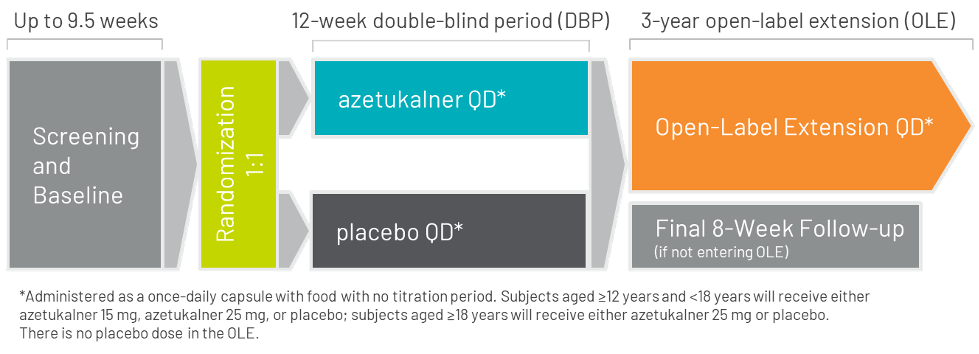Azetukalner (PGTCS)
Azetukalner is a novel, potent Kv7 potassium channel opener being developed for the treatment of epilepsy, major depressive disorder, and potentially other neurological disorders.
Azetukalner for Primary Generalized Tonic-Clonic Seizures (PGTCS)
Potassium channels play a major role in the control of neuronal excitability and represent a promising treatment target for epilepsy. Xenon’s Phase 3 epilepsy program includes an ongoing Phase 3 clinical trial, X-ACKT, in primary generalized tonic-clonic seizures, or PGTCS.
For those living with primary generalized tonic-clonic seizures, you may be eligible to enroll one of a Phase 3 clinical trial. Learn more here.
Phase 3 X-ACKT Study Design
X-ACKT is a Phase 3, multicenter, randomized, double-blind, placebo-controlled study to evaluate the efficacy, safety, and tolerability of azetukalner as adjunctive treatment in adults aged ≥12 years with a seizure frequency of ≥3 PGTCS during the last 8 weeks of the baseline period and taking 1 to 3 antiseizure medications, or ASMs.

Approximately 160 eligible subjects will be randomly assigned 1:1 (azetukalner 25 mg : placebo taken once-daily with food with no titration period).

Screening/baseline period: Up to 9.5 weeks duration to assess the frequency of seizures.
Double-blind period (DBP): 12 weeks duration. There is no titration period.
Follow-up period: 8 weeks duration after the last dose of study drug for subjects who do not complete the 12-week DBP or who complete the DBP but do not enter the OLE study.
On completion of the double-blind period in X-ACKT, eligible patients may enter an open-label extension study for up to three years.
Primary efficacy endpoint

Median percent change in monthly PGTCS frequency from baseline through the DBP of azetukalner versus placebo.
Click on the following link for more details about the X-ACKT clinical trial.
About Primary Generalized Tonic-Clonic Seizures
Epilepsy is a chronic neurological disorder, the hallmark of which is recurrent, unprovoked and unpredictable seizures. Individuals are diagnosed with epilepsy if they have two unprovoked seizures (or one unprovoked seizure with the likelihood of recurrent seizures) that were not caused by a known and reversible medical condition.
Generalized onset seizures affect both sides of the brain or groups of cells on both sides of the brain at the same time. This term includes primary generalized tonic-clonic seizures, or PGTCS, absence seizures, and atonic seizures. Generalized onset seizures account for approximately 30% of seizures in the U.S., or approximately 0.9 million patients, of which the majority experience PGTCS. The remaining 10% of seizures in the U.S. are characterized as unknown onset seizures, which occurs when the beginning of the seizure is unknown. As more information is learned, unknown onset seizures may later be diagnosed as focal onset or generalized onset seizures..

Addressing an Unmet Medical Need
Numerous ASMs are available for the treatment of seizures in the U.S., although there are fewer indicated for PGTCS. The treatment of an individual patient with PGTCS is currently focused on reduction of seizure frequency, with seizure freedom as the ultimate goal. Early treatment typically begins with monotherapy followed by increasing use of polypharmacy to manage patients with residual seizure burden. Despite the availability of multiple treatment options, up to 50% of patients are considered inadequately managed with initial lines of therapy warranting additional treatment options. For poorly managed patients, physicians increasingly turn to complementary mechanisms used as adjunctive therapy to control seizures. We believe there is a need for new, more effective and tolerable ASMs that have rapid onset of action, unique mechanisms important in polypharmacy, are easy to take (for example, once-daily), and durable.